Green Machine
Famous boatbuilders turn a Contessa 32 into an eco-friendly family boat
Story and photography by Nic Compton
There's not much that Jeremy and Fiona Rogers don't know about building durable production yachts. Best known for their iconic Contessa 32, they were churning out a boat a week at the peak of production in the 1970s. At the same time, they collaborated with Doug Peterson to produce a long line of successful Admiral's Cup racers.
Equally, there's not much that Kit and Jessie Rogers don't know about sustaining endangered sea creatures. Both are former activists who worked on whale research and filming vessels for more than 10 years. They met after Kit (Jeremy and Fiona's son) was arrested in the Galapagos Islands for protesting the over-fishing of sea urchins, and Jessie interviewed him for a news story for Reuters. The couple subsequently bought a 60-foot ketch that was used for filming the BBC "Blue Planet" series, before returning to the United Kingdom after the birth of their first son.
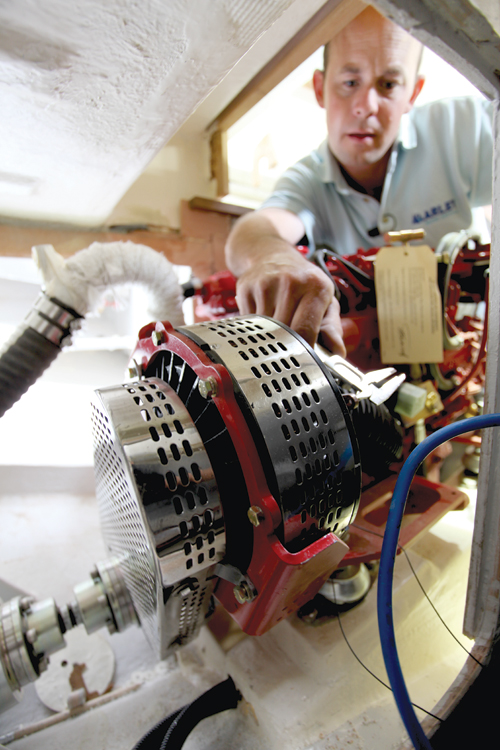
When the two generations of Rogers-the "blues" and the "greens"-started discussing building a family boat, there was never really any question what the design would be, especially as Jeremy just happened to have a "spare" Contessa 32 deck that "needed using up." What was equally clear, however, was that the boat would not be a standard Contessa, fitted out with the usual hardwoods and only running a carbon-emitting diesel engine. For both the blues' and the greens' requirements to be satisfied, there would have to be compromises on both sides.
The debate really got going over the issue of what timber to use. Tropical hardwoods were not an option because the timber was either unsustainable or, if it was farmed, it was grown too quickly and was therefore not durable. But what were the alternatives? After some research, they discovered Kebony, an impregnated timber that is billed as a sustainable alternative to tropical hardwoods. By cooking locally grown timber such as pine and maple in a vat of furfuryl alcohol-a byproduct of the sugar industry-the manufacturers create a wood that is not only as durable as teak but also looks similar, even graying to a similar color. And, unlike other impregnated wood systems, it does not leach toxic chemicals and can therefore be disposed of without damaging the environment.
The test was whether Jeremy, the blue camp's master craftsman, liked it. He would be machining hundreds of feet of the stuff, so it had to be workable as well as sustainable. Jeremy's verdict was that Kebony was actually harder than teak and a little more brittle, making it ideal to shape with electric tools but harder to work by hand. Overall, he gave the wood an enthusiastic thumbs-up and reported that it made the workshop smell of molasses.
The discovery of Kebony opened the eco floodgates and made the Rogers (of both colors) realize that there were environmentally friendly marine products out there, but that they would have to break out of their usual habits to find them. The issue arose again over what adhesive to use to apply the Kebony decking to the fiberglass deck. The automatic choice for most boatbuilders would be the ubiquitous Sikaflex, but this product contains isocyanates, which are carcinogenic and known to cause asthma. Instead, the green Rogers sourced Saba, a solvent-free sealant produced in Holland, which has the added benefit of not going off in the tube, thereby reducing waste.
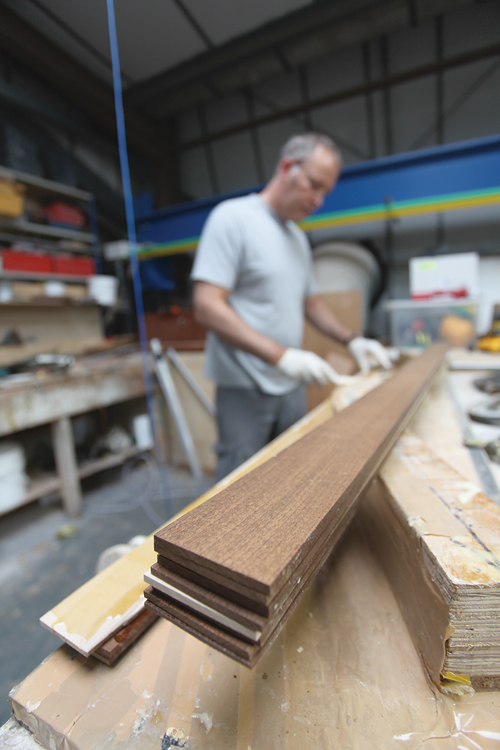
By now, the Rogers's eco-boat had attracted the attention of The Green Blue, an environmental initiative set up jointly by Royal Yachting Association and the British Marine Federation. The organization was supportive of the project, but wondered whether a GRP hull could be genuinely green, given that it uses so much of one of the world's scarcest resources, oil. It was a question I put to Jessie when we met just before Calypso's maiden sail.
"It's true that GRP is not an obvious eco-choice," she said. "But if you think that a well-built GRP boat will last many generations, if not forever, then it seems like a sensible use of resources. It's a lot less wasteful than flying to New York. The real issue is disposing of it, as badly-built boats end up in landfills in 10 to 15 years time. But there are many Contessa 32s that are 30 to 40 years old and still sailing."
The Green Blue were apparently persuaded by the Rogers's argument in favor of GRP and offered them a place at the next Southampton Boat Show providing they turned the boat into a showcase of environmentally friendly marine products. With the show six months away and a clear green agenda to follow, suddenly the pressure was on. And the more the Rogers investigated, the more questions they came up against.
An early dilemma was the means of propulsion. A conventional diesel engine was, of course, out of the question, but while an electric engine had obvious green appeal, the idea of fitting a fixed-bladed propeller to charge the batteries under sail was anathema to the blue camp because of the extra drag it would create.
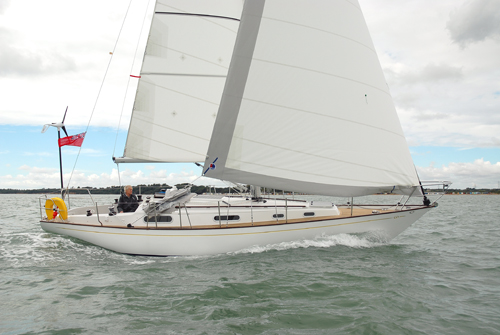
The solution came in the form of Graeme Hawksley of Hybrid Marine, who has created an electric/diesel system that combines the best of both worlds. An electric motor piggybacks a standard Beta diesel engine and, by locking the prop in reverse, turns into a giant dynamo that charges the batteries while under sail. In diesel mode, the system runs the engine at optimum revs, regardless of cruising speed, and uses any surplus power to recharge the batteries. The batteries can also be charged by solar panels, wind turbine and shore power. The blue team's concern about drag was addressed by fitting a feathering prop that can be streamlined when not charging.
Once the boat was fitted with such a powerful generating capacity, it was tempting to go all the way and make it all-electric, including the stove and heads. There was even talk at one point of fitting a microwave. In reality, however, the batteries needed to feed so many appliances would have taken up too much space, and so compromises had to be made. In any case, while the Rogers were keen to put green technology to the test, they didn't want to put all their eggs in one basket. So a gas stove was installed (albeit 30% more efficient than a normal one), and a manual loo-and no microwave.
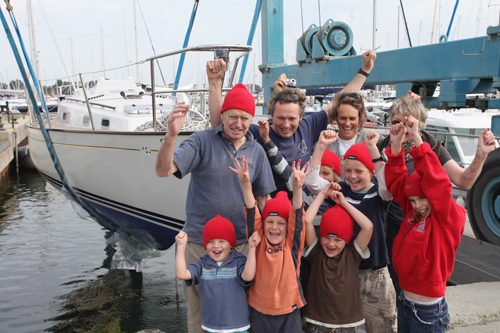
In truth, there was no absolute green standard that was applied to the project. So, while one product might be genuinely sustainable (such as the solvent-free vanish from Le Tonkinoi), another might be manufactured by a company that simply had better eco credentials. Winches fell into the latter category. Harken was chosen not because their product was any more biodegradable than anyone else's (though at 40% lighter than earlier models, they clearly do use less resources) but because the company practices policies such as energy conservation, recycling and teleconferencing. Likewise Garmin, who Jessie likens to "the Google of electronics" for its uncanny ability to be ahead of the curve, was chosen for similar reasons. An ISO1401 accreditation for sustainable management from DEFRA helped too.
"Some companies just seem to get it," Jessie says, "and some don't."
The green camp also came up with an innovative solution when it came to antifouling. Steering well away from the traditional copper-leaching paints, they came up with Hempasil X3, a rubbery coating so slippery "that nothing in the foul family can really get its toes in," according to Jessie's blog. The product is most efficient at speeds above 7 knots, when not only does algae miraculously drop away, but there is a significant increase in fuel efficiency. The application is currently used for commercial shipping and military vessels-not so much for its green credentials but for saving on fuel costs-and Calypso is thought to be the first yacht to be treated with it. Once the Hempasil has been thoroughly tested, the Rogers will try out an ultrasonic system that is designed to scare weeds away by emitting sound waves. Seriously.
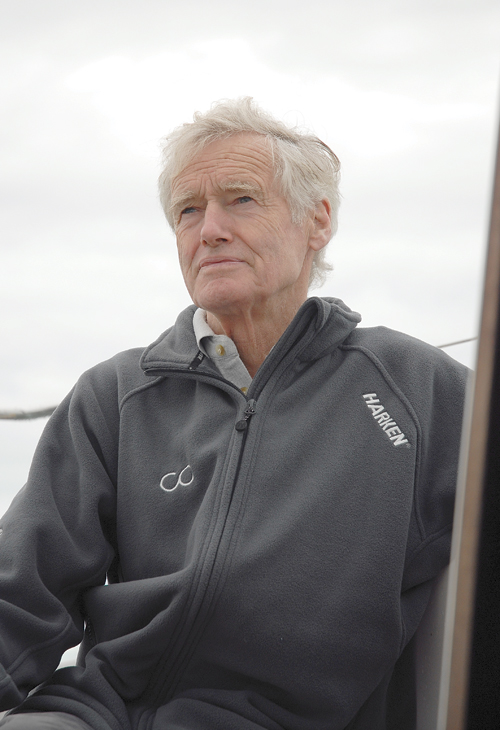
It was raining when we headed down to Lymington yacht haven for Calypso's maiden sail. At first glance, she looked just like any other Contessa 32-albeit one fitted with a solar panel on the coachroof and a wind turbine on her pulpit. The rich brown Kebony decks might have been freshly laid teak, and the varnished dark brown Kebony trim some exotic rainforest timber.
As we backed out of our berth, however, there were a couple of clues that the observant passerby might have spotted. Firstly, they might have noticed that Jeremy didn't bend down to change gear, but maneuvered the boat using three touch buttons embedded in the tiller-a big improvement on the usual awkwardly positioned morse controls. Secondly, they would have noticed a strange silence. Well, silence might be an exaggeration, as the 17-inch Featherstream prop was in need of adjustment, but even so, the noise at cruising speed was no more than a conventional diesel engine makes while idling.
There was a light westerly breeze blowing in the Solent, and the electric motor immediately came into its own, giving an extra boost of speed with minimum fuss. My excitement was slightly dented by the discovery that, at our cruising speed of 4 knots, the batteries' range was just two hours-less if the engine was throttled up. That said, there are six different ways of charging the batteries, so it shouldn't take long to be back in business, and fitting lithium-ion batteries would greatly increase the range. As it was, we eventually had to switch over to diesel when it became apparent that if we didn't hurry up we might lose our berth at the boat show!
Belowdecks, the varnished Kebony makes a striking contrast with the white deckhead and cotton upholstery (made from canvas sourced from a family-run mill in Spain). Some people will love it, some people will find it too dark, but in any case it certainly draws attention to the issue of wood and why this type has been used. The layout is the same as the standard Contessa, and many of the details have been carried over from the Rogers's previous boat Gigi. There are some nice new touches, such as the wooden seat backs, with loose cushions instead of fitted upholstery. And, instead of the usual hanging locker forward, there is a set of drawers and a narrow seat opposite the heads.
More green features are in evidence in the galley, which boasts a super-efficient fridge, shaped to the side of the hull, as well as space for recycling. But the coup de resistance is the Quooker boiler that, for a small electrical input, provides instant hot water at 100°C for drinks, cooking and washing up.
There is of course a price to pay for such eco-technology, and that is the notion of simplicity. Calypso fairly bristles with high-tech gadgets, and almost every other locker seems to contain some gizmo flashing a light at you. But perhaps that isn't the point. More than presenting a definitive solution, the yacht raises important issues about boatbuilding methods and shows what is possible. Some of the ideas will appeal, some won't, but if it merely raises awareness of the issues, then it will have achieved what the greens wanted. As for the blues, Calypso proves that you can turn green without compromising comfort or safety. And that is something worth shouting about.

Comments